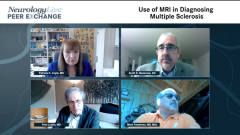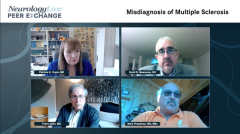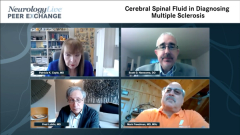
Use of MRI in Diagnosing Multiple Sclerosis
Episodes in this series

Scott D. Newsome, DO, outlines the importance of the use of MRI in diagnosis of multiple sclerosis.
Fred Lublin, MD: Scott, give us the actual criteria for dissemination in space and time by MRI.
Scott D. Newsome, DO: We look at the periventricular region, the infratentorial region, juxtacortical lesions, and spine. You need at least 1 T2 lesion and 2 of those characteristic areas to fulfill dissemination in space while we think about the imaging. I’ve been doing this for a while—maybe not as long as you, Fred—and predictably, when you see those areas get involved, it can help separate that this is a demyelinating disorder vs something like neurosarcoidosis or NMO [neuromyelitis optica], for example.
To answer your main question about the McDonald criteria, initially they have helped. This is evidence based, by the way. It has helped whittle down the need for number of lesions in certain spaces and aided in the earlier diagnosis of MS [multiple sclerosis]. We know from clinical trials that the earlier you can get people on therapy, the better people will do long term. That’s the main goal.
Fred Lublin, MD: OK. What about criteria for dissemination in time?
Scott D. Newsome, DO: Those require an enhancing lesion, or a new T2 lesion over time if you do a repeat MRI, even if it’s within a month of their reference. Based on MRI, if you see a new T2 lesion, then that would be classified as MS.
Fred Lublin, MD: When you say enhancing, it’s a single scan with both enhancing and nonenhancing lesions.
Scott D. Newsome, DO: Correct.
Fred Lublin, MD: There are 2 very important dictums in understanding the McDonald criteria. One is that they are for diagnosing multiple sclerosis, not for differentially diagnosing multiple sclerosis. There are other disease states and conditions that can give you dissemination in time in space. This is for getting to the issue of diagnosing MS.
The second is that the McDonald criteria are based on an initial episode or a clinically isolated syndrome of a typical type. That could be optic neuritis, a brain stem cerebellar inflammatory syndrome, or a partial myelitis. Other presentations are more problematic and lead to this issue of misdiagnosis that was discussed in McDonald 2017.
Newsletter
Keep your finger on the pulse of neurology—subscribe to NeurologyLive for expert interviews, new data, and breakthrough treatment updates.
























































